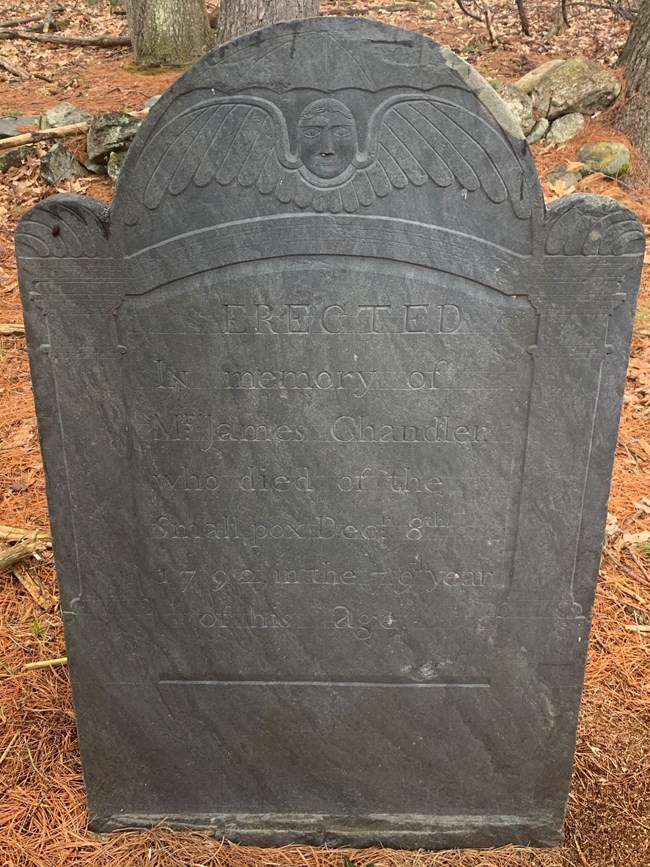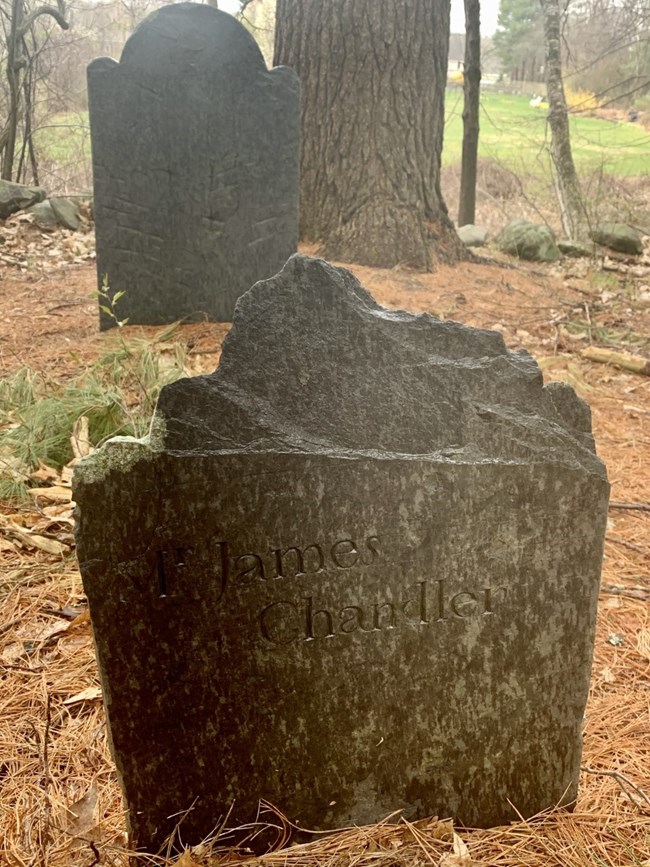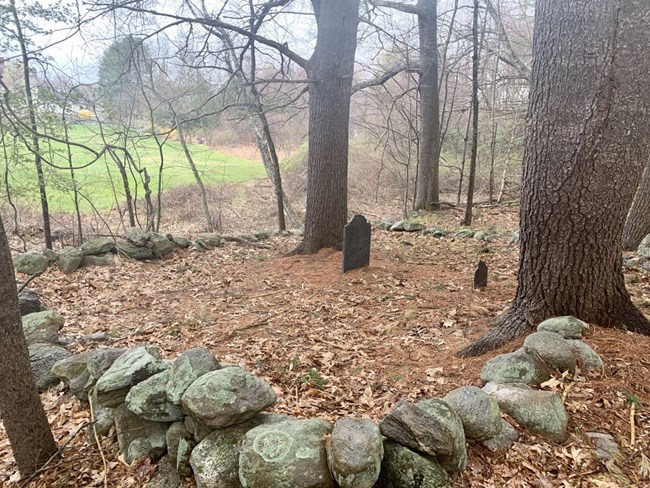
Jarrad Fuoss IntroductionIn a secluded woodlot near the home of Col. James Barrett there is a solitary grave, marked by a late 18th century headstone. Surprisingly the grave is not that of a British soldier nor anyone killed on April 19, 1775, though it does capture a tragic aspect of Concord’s past and the town’s spirit of survival. Tucked into the folds of a small hillside and surrounded by a low stone wall is the grave marker “Erected In Memory of Mr. James Chandler who died of the Small Pox Dec 8th, 1792 in the 79th year of his age.” Although the marker has remained beautifully undisturbed for nearly 228 years, there is much the grave of Mr. Chandler can tell us. The Life of James ChandlerJames Chandler, born August 28, 1714, lived an incredible yet tragic life. At the age of 23, Chandler married Ms. Mary Wright and the couple had two children before purchasing a home not far from Col. James Barrett’s farm in 1746. Unfortunately, tragedy struck the very same year and Mary Chandler died. Mary’s family buried her in Concord’s Old Hill Burying Ground with the inscription on her grave reflecting her faith; “Life is short but death is sure, Sin is the wound, God is the cure.”1 Now a single father with two children to care for, James Chandler married again in 1747. This second marriage to Mary Flagg bore two more children; however happiness did not last long. Just six years after their union, his second Mary also passed away. A widower twice over, James buried Mary in Concord’s Old Hill Burying Ground with the inscription on her stone warning “memento mori,” Latin for “remember that you must die.” Mary Flagg Chandler’s epitaph goes on to say, “Here mix'd with earth, her ashes must remain Till death shall die, and mortals rise again.” Over the next three years, the twice widowed James raised his four children at their farm near the Concord River. In 1756 James Chandler married his third wife, Mary Whiteaker, and shortly thereafter the couple welcomed a daughter into the world. This time love would last and Mary survived to the age of 74, dying in 1791, just one year before James would succumb to smallpox. The family buried her in Concord’s Old Hill Burial Ground; her epitaph reads “Death like an overflowing flood, Do sweep us all away.” During the later years of his life, James Chandler heavily engaged in local politics, acting as a selectman in Concord for several years and holding the rank of Ensign in the town militia. When political tensions reached a boiling point in 1774, Chandler was too old for active service, but helped the rebel cause by serving as a member of Concord’s Committee of Correspondence. On April 19, 1775 Chandler helped subvert British search efforts by storing five kegs of gunpowder in his home. Though the Regulars raided Col. Barrett’s farm only yards away, they did not discover Mr. Chandler secret and he escaped the day unharmed.2 
Jarrad Fuoss The Epidemic of 1792James Chandler may have survived the famous events of April 19, 1775, however his death 17 years later marked another important and dark time in Concord’s history. In an era before germ theory and the scientific understanding of disease, smallpox often came in waves that ravaged communities without warning. Easily spread and often bringing symptoms that included fever, body-aches, blistering rashes and blindness, the disease killed quickly. In 1721, James Chandler lived through one of the largest recorded smallpox epidemics in Boston and the subsequent aftershocks that followed year after year. While the virus claimed many lives in Concord annually, certain years saw larger epidemics spread through the countryside. When smallpox took hold within a community very little could be done to alleviate the disease. Physicians frequently used quarantine and isolation to stop the rapid transmission of the virus, however sometimes those measures were not enough. By 1726 Boston Physician Zabdiel Boylston introduced the new and controversial practice of inoculation to the population of Massachusetts.3 Far from the precise science of epidemiology and infectious disease control we know today, physicians discovered the intentional introduction of weakened versions of viruses like smallpox resulted in higher survivability rates for those infected. These inoculations proved an incredible lifesaving measure for the people of Boston. In 1776 the Siege of Boston presented a vulnerable gathering of people and the opportunity for medical advancement. The already crowded town hosted upwards of 4,000 British soldiers and the besieging colonial militia numbered nearly 20,000. An outbreak of smallpox under these circumstances would be devastating, but the inoculation of colonial soldiers and civilians granted some protection and saved countless lives. In 1776 Abigail Adams even wrote that “The fatal effects of the small pox there, has led almost every person to consent to Hospitals in every Town. In many Towns, already around Boston the selectmen… have granted Liberty for inoculation. I hope the necessity is now fully seen.”4 Although many undertook inoculation and spared Boston from catastrophe, the practice remained controversial in many religious circles as an interference with divine will. When news of another smallpox outbreak in Boston reached Concord in 1792 the community acted quickly. As one early historian noted in 1835, “A hospital was fitted up where Mr. Augustus Tuttle now lives; and 130 persons went there, at several times, to be inoculated under the care of the three physicians of the town. From some cause the disease spread.” To fight the outbreak, Concord set up a hospital at the home of Ephraim Potter however casualties quickly mounted. Near what became known as the “Pest House,” “a small burying-ground and grave-stone now mark the melancholy ravages of this disease. Ten persons were its victims,-- 2 by inoculation and 8 by contagion,-- and were buried by themselves; it being considered improper to inter them in the usual ground.”5 Common practice in the period required the immediate burial of victims to avoid further spread, thus several isolated smallpox cemeteries appeared around Concord. Today, the “Pest House” and cemetery still exist along Fairhaven Road in Concord.6 
Jarrad Fuoss Although Concord’s physicians attempted to slow transmission through quarantine and inoculations, the virus eventually made its way to the home of James Chandler. Presently, it is unknown if any additional Chandler family members contracted the disease. When James Chandler succumbed to smallpox on December 8, 1792, his surviving children and neighbors confronted the problem of burial. Unable to transport James’s body to Concord for burial near his wives, his children instead selected a small plot at the edge of their own property. In the years following James Chandler’s death his home near Col. Barrett’s was removed; possibly demolished for fear of further smallpox infection.7 Today, Chandler’s grave remains, marked by a large slate headstone adorned with the common mortuary depiction of a late-18th century “Death’s Head,” as well as the inscription mentioned above. Although Chandler’s grave is the only marked burial in the confines of the small plot, further research is needed to determine if he is truly the only smallpox victim buried there. In total, 26 persons died from the 1792 smallpox epidemic, slightly more than the average of 24 persons the disease claimed a year in Concord from 1779-1828.8 ConclusionWhile James Chandler’s life came to a tragic end, it serves as a story of hope in the modern era. During his 79 years of existence, Chandler married three times, raised five children, helped create a new nation, and though he did not benefit, observed the wonder of medical advancements like inoculation. James Chandler’s death, along with the millions who lost their lives to smallpox, informed medical science into the modern era. In 1796 the introduction of a new smallpox vaccine significantly decreased the devastation of the disease and less than 188 years later in 1980, the World Health Organization certified smallpox globally eradicated; the result of widespread vaccination and proper medical care.9 Chandler’s humble grave reminds us that the past and present share a deep connection that we continue to learn from. Citations |
Last updated: May 7, 2020
